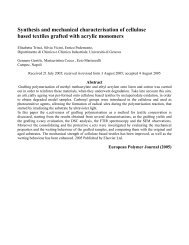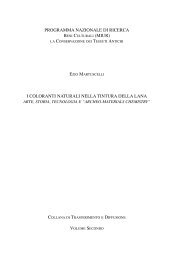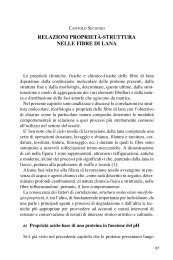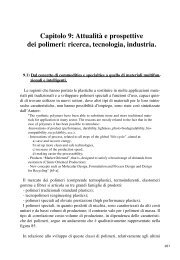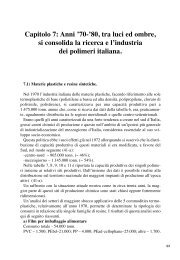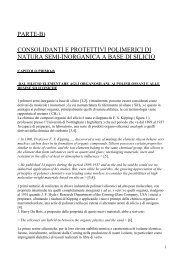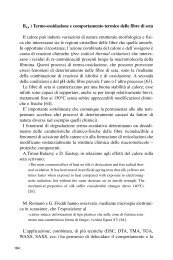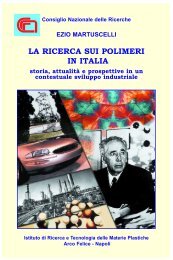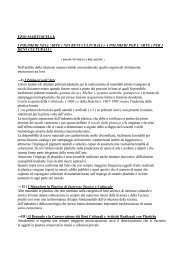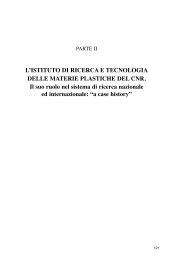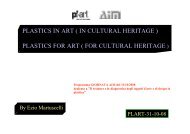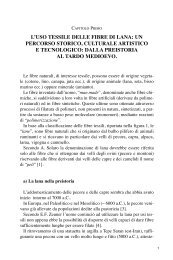ON- POLYMERS - ezio martuscelli
ON- POLYMERS - ezio martuscelli
ON- POLYMERS - ezio martuscelli
Create successful ePaper yourself
Turn your PDF publications into a flip-book with our unique Google optimized e-Paper software.
WITH THE GROWTH OF POLYMER INDUSTRY PLASTICS ARTIFACTS BECOME A<br />
RELEVANT PART OF THE CULTURAL HERITAGE<br />
By Ezio Martuscelli<br />
Many plastics artefacts have been recognised to be relevant part of the world cultural heritage. As<br />
matter of fact items in plastic materials ( radios, records, clocks, fountain pens, jewellery and hair<br />
accessories, robots, dolls, brooches, inkwell, perfume botles, sculptures and paintings based on<br />
synthetic varnishes and binders, etc. ) found place in historic and technological collections of the<br />
twentieth century.<br />
The birth of the modern plastic industry goes back to the end of the nineteenth century and the<br />
beginning of the twentieth century following the development of the Celluloid and of the Bakelite.<br />
Because of the rapid expansion of plastics utilization in more and more different sectors the<br />
twentieth century was defined as the “Century of Plastics”.<br />
The sweeping growth of plastic industry was originated by several factors some of them are<br />
hereafter listed:<br />
--- the understanding of the basic principle of the macromolecular chemistry;<br />
--- the development of new methods of molecular characterization;<br />
--- the set up of new controlled and reproducible procedures of chemical synthesis, favoured by the<br />
development of innovative and specific catalysts, suitable to obtain a great number of new “man<br />
made” polymers with widely different characteristics;<br />
--- the implementation of the chemistry of additives, fillers, pigments and colorants;<br />
--- the development of innovative methods of processing and transformation [1,2,3].<br />
The term “Plastics” is commonly used to indicate polymer-based formulations (I. e. a compound<br />
made by a mixture containing a polymer, as main component, and additives, fillers, pigments etc.)<br />
suitable to be transformed and shaped with the aid of temperature and pressure.<br />
Polymers, according to their behaviour to heating and pressure cycles, may be divided in:<br />
Thermoplastics -A material constituted by linear macromolecules able to be repeatedly soften or<br />
melted when heated and to harden under cooling. Polymers such as polystyrene, polyethylene,<br />
nylons, etc., are examples of thermoplastic materials.<br />
Thermosetting - A polymer that while is shaped, when is heated under pressure, forms, in presence<br />
of suitable catalysts, a three dimensional molecular network becoming permanently solid. The<br />
resultant material cannot be re-melted or remoulded. Epoxies, phenol-formaldehyde resins,<br />
unsaturated polyesters, etc., are typical thermosetting resins.<br />
Plastics are usually classified according to the origin of the polymer constituent in:<br />
I) Natural Plastics- these include horn, hoof, natural rubber, casein and shellac.<br />
Ii) Semi-synthetic or artificial Plastics - Are obtained from chemical modification of the<br />
macromolecules of natural polymers such as cellulose (for example, cellulose nitrate and cellulose<br />
acetate).
Iii) Synthetic Plastics- they are newly synthetised by the man starting from small molecules, called<br />
monomers. The “Era” of synthetic plastics begun in 1908 when Leo Hendrix Baekeland patended<br />
the synthesis procedure and the method of processing of the phenol formaldehyde thermosetting<br />
resins ( comonly called Bakelite in honor of its inventor ).<br />
Polyvinyl chloride (PVC), polymethyl methacrylate( PMMA) , polyethylene, polyamide (Nylon),<br />
polyacrylonitrile, polyurethane, polycarbonate, saturated and isaturated polyester, epoxies, , teflon,<br />
etc., belong to the synthetic era of plastics.<br />
The number of synthetic polymers developed since the beginning of the twentieth century is<br />
enormous. These compounds differ dramatically from each other as far as their proprties are<br />
concerned. Thus the identification of the type of plastic from which an artefacts is made represents<br />
one of the main problem that one must afford for the sake of their conservation.<br />
Plastics, since the birth of the polymer industry, were preferred, in many applications, to traditional<br />
materials such as, wood, metal, glass, ceramics, ivory, etc.<br />
The advantages in using Plastics materials, constituted by polymer based formulations, rather than<br />
traditional materials, were essentially the following:<br />
---Easy processing;<br />
---Low production cost;<br />
---Weight saving;<br />
---Colourability<br />
---Innovative performances;<br />
---High rate of production.<br />
The disadvantages in making items in plastics were mostly related to:<br />
---Instability against environmental and internal degradation factors;<br />
---Necessity to use additives (stabilizers, plasticizers, fillers, aid processing etc.).<br />
Artefacts in plastics, more and more present in private collections and in many museums including<br />
the art museums and the science museums, may be subdivided in the following two broad<br />
categories: artistic objects and items of historical and cultural interest.<br />
A ) Plastics in artistic objects<br />
Plastics had ( still have ) an important function in the structuration of works of art. They represented<br />
( represent ) an important means of expression of artists and designers.<br />
According to G. Williams, the reasons which convinced artists and designers, since the beginning of<br />
polymer Era, in using plastic materials for their works, may be summarized as follows:<br />
< It is amongst the most versatile group of materials known, with different varieties notable for<br />
their relative strengths, ranging from total rigidity to complete flexibility, not to mention inertness<br />
and stability. Plastics enabled the development of an infinite number of novel shapes and colours<br />
which were impossible to achieve using natural materials. The moulding of plastic requires<br />
expensive tooling and a high degree of industrialisation, yet the resulting products can be massproduced<br />
cheaply and in great quantity. Versatility, novelty and the potential for replication were<br />
the perfect qualities of any material for the manufacturers of new consumer goods > [4].
Early attempts in using plastics as materials for making works of art go back to the end of<br />
nineteenth century when processes, suitable to transform by compression moulding compounds<br />
based on natural polymers in objects having the shape designed by the die engravers, were invented<br />
[5].<br />
The causes that conferred the success to plastics as a means of expression of artists and the relevant<br />
role in the field of modern fine arts were related also to the following factors:<br />
---Easy availability, low weight and cost;<br />
---Innovative mechanical and chemical characteristics;<br />
---Mouldability alternative to carving;<br />
---Easy colourability by using natural or synthetic pigments ( see figure 1 ) [6];<br />
FIGURE 1: The development of new plastics and pigments led to the production<br />
of materials having a wide variety of colors.<br />
Left, a catalogue ( 1936 ) of the Catalin Company showing “the coloured gem<br />
of the modern industry” based on phenol-formaldehyde resins.<br />
Right, set of samples in vinyl acetate from which emerged the opportunity to buy<br />
materials with a wide different coloration [6].<br />
Polymer formulations were used by artists essentially in two different forms of art, namely in<br />
sculptures, by molding, casting and carving methods, ad in paintings.<br />
Plastics in artistic sculptures<br />
From historically point of view plastics begun to be part of the repertory of materials suitable to be<br />
used for artistic sculptures at early decennia of twentieth century when Naum Gabo ( 1890-1977 ),<br />
< known for his sculptural experiments with constructivism >, experienced the use of celluloid in<br />
making innovative works of art [7].<br />
Previous to that artistic artifacts, as shown in figures 2 and 3, were also produced by using different<br />
type of natural plastics, in the so called pre-synthetic Era [8,9].<br />
Examples of different types of artificial and synthetic plastics used in artistic sculptures belonging<br />
to various time periods, are reproduced in figures 4 to 8.
FIGURE 2-left: Artistic object in ebonite<br />
( hardened natural rubber ) 1878-1900 [8].<br />
FIGURE 3-right: exemplary of daguerreotype,<br />
( period of American civil war ) obtained by<br />
compression molding of a mixture of shellac and<br />
sawdust [9].<br />
FIGURE 4-left: Work by Naum Gabo “Construction in Space<br />
with Crystalline Centre” (1938-40 ), in polymethylmethacrylate (<br />
PMMA ) and celluloid [10].<br />
FIGURE 5-left: Sculpture, “Adamo e Eva”, obtained by carving<br />
a sheet in polymethylmethacrylate, by Marcel Ronay, ( I. C. I.<br />
Plastics Division ) [11].<br />
FIGURE 6-left: Marcello Morandini, scuplture in PMMA [12].<br />
FIGURE 7-right: Guido Drocco, Franco Mello, Cactus,<br />
expanded polyurethane ( Gufram, 1972.) [13].
FIGURE 8: Sculpture in epoxy resin by<br />
Frank Gallo, Awakening Beauty, USA,<br />
1933 [14].<br />
Plastics as components in artistic paintings<br />
Formulations based on synthetic polymers are more and more used as binders and protective<br />
varnish in the manufacture of artistic paintings. The binders and the protective varnishes, as<br />
schematically shown in figure 9 are the main component of paintings that are structured according<br />
to the following different layers:<br />
1 ) The support: The most common used supports, characterized by a high level of stability, are<br />
wood, walls and canvas.<br />
2 ) The preparation layers. Are composed of a mixture containing binders ( animal glues, Arabic<br />
gum, casein, oils, eggs, waxes, etc. ) and white pigments [ gypsum ( CaSO 4 2H 2 O ), chalk ( CaCO 3<br />
), lead white ( 2PbCO 3 Pb(OH) 2 ), zing white ( ZnO ) ] or other opaque pigments such as, red and<br />
yellow hearth. The artists normally use such a layer for their drawing and template [15,16].<br />
3 ) The Painting layers. Are constituted by pigments/colorants mixed with binders and a vehicle<br />
agent ( oil or water ) that all together form a liquid or paste suitable to be applied to a surface to<br />
provide an adherent coat that imparts color to the preparation layer. Generally the binders used in<br />
painting layers and in preparation layers have the same nature and chemical structure [15].<br />
4 ) The Protective layers. Are transparent and translucent films, obtained by solidification from a<br />
suitable varnish formulation, having as main function that of protecting the underlining painting<br />
layers against the environmental factors of degradation ( SOx, NOx, UV light, smog, soot, etc. )<br />
[15].
FIGURE 9: Model showing the layer structure of a painting<br />
[15].<br />
Binders are defined in reference [17] as follows:<br />
< A resin or other cement like material used to hold particles together and provide mechanical<br />
strength or to ensure uniform consistency, solidification, or adhesion to a surface coating; typical<br />
binder are resin, glue, gum, and casein > [17].<br />
In painting art the binders, while are hardening forming a transparent coat, should be able to fix the<br />
pigments and dyes to the preparation layer without influencing their colors.<br />
Binders should also have the capability to:<br />
--- give to paints a high chromatic yield, brightness and brilliancy;<br />
--- implement the solidity of the paints against the physical and chemical factors of deterioration<br />
[15,16].<br />
Varnish formulations, used for coating the surfaces of the paintings, according to reference [17] can<br />
be defined as follows:<br />
< A transparent surface coating which is applied as a liquid and then changes to a hard solid; all<br />
varnishes are solutions of resinous materials in a solvent > [17].<br />
Varnishes have not only the role of render more homogeneous and brilliant the surface but also that<br />
of protecting the underlying painting, including pigments, against the action of water, light and<br />
chemical pollutant agents. Before the development of synthetic resins several types of natural<br />
substances that derived from animal or vegetal world were used as binders in the painting art (as<br />
example, terpenes, proteins, polysaccharides, drying oils, etc. ).<br />
Just before the Second World War the chemistry industry developed several types of synthetic<br />
binders with innovative performances and properties and tailored to be used also in the field of<br />
painting art.
Such a new products very soon began to replace natural materials. According to R. Mustalish this<br />
substitution process happened essentially because:<br />
< They were cheaper and more readily available, especially during World War II, when natural<br />
raw materials were difficult to obtain.<br />
They also appealed to artists who wanted to experiment with non traditional materials to create non<br />
traditional art > [18].<br />
Some of the characteristics of synthetic binders are hereafter summarized:<br />
i) can be easily used;<br />
ii) are able to induce brightness;<br />
iii) their hardening is very fast;<br />
iv) the painting film is high elastic;<br />
v) they may be applied directly on no pre-treated canvas;<br />
vi) in some cases they may be used also as protective surface varnish.<br />
The denomination and the chemical structure of monomers and of repetitive units of polymers that<br />
are the constituents of the most common synthetic binders are shown in figures 10 [16].<br />
Among those reported in figure 10 the most used synthetic binders for artistic paints definitely were<br />
the alkyd, vinyl and acrylic resins whose molecular structures are depicted in figure 11 [19].<br />
In 1946 the Bocour Artists Colors Inc developed a line of paints specific for artistic use, based on<br />
acrylic resin dissolved in organic solvent , marketed as Magna.<br />
< these highly pigmented paints, which could be thinned with turpentine and used with oils, made<br />
them immediately attractive to modern artists such as Morris Louis, Kenneth Noland, Jules Olitski,<br />
and Roy Liechtenstein > [18].<br />
In 1955 the Permanent Pigments Inc. commercialized the first paint for artists based on acrylic<br />
resins dispersed in water ( marketed as Liquitex ). < Andy Warhol and Helen Frankenthaler were<br />
among the first artists to use this new medium > [18].<br />
The most relevant peculiarities of paints, based on water emulsions of acrylic resins, have been<br />
summarized as follows by R. Mustalish [18]:<br />
< --- They can be diluted in water instead of turpentine or paint thinner,<br />
--- they dry very quickly, and, unlike Magna color, they do not resolubilize with the addition of<br />
other layers of acrylic. This allows the artist to paint layer upon layer without disturbing the<br />
previously applied paint.<br />
--- Acrylics also cause less change to paper and textiles, giving the artist more freedom in choosing<br />
supports for the work of art > [18].<br />
Starting from 1950s the acrylic water emulsion based paints were more and more used by artists<br />
substituting most of polyvinyl acetate emulsion paints.<br />
According to G. Martinez the introduction of acrylic resins represented a revolution in the field of<br />
artistic paintings comparable only to the first use of oil painting by the Flemish painter Van Eyck<br />
[14].<br />
It is interesting to point out that now a days most of commercial canvas are prepared by using<br />
acrylic emulsion able to impart an higher flexibility in comparison to more traditional substances<br />
[20].
a) Vinyl Polymers----------------------<br />
b) Acrylic resins---------------------<br />
c) Diene Polymers ----------------------<br />
d) Polyurethanes----------------------<br />
e) Alkyd resins-----------------------<br />
f) Epoxy resins ----------------------<br />
FIGURE 10: Name and chemical structure of monomers and of repetitive units of<br />
polymers that are the constituents of the most common synthetic binders.<br />
a), Vinyl polymers, ( top: vinyl alcohol and poly vinyl alcohol; bottom: vinyl acetate<br />
and polyvinyl acetate ); b), acrylic resins ( top, acrylic esters and polyacrylates ), (<br />
bottom, meta acrylic esters and poly meta-acrylates; c), diene polymers, butadiene and<br />
polybutadiene; d) Polyurethanes, di-isocianate and diol, polyurethane; e) Alkyd resins,<br />
( top: fat acid, polyol and aromatic di-carboxylic acid ), ( bottom: alkyd resins ); f)<br />
Epoxy resins, ( top: di-epoxy monomer and di-amine ), ( bottom: epoxy resin<br />
crosslinkable ) [16].
FIGURE 11: Molecular structure of the most used<br />
synthetic binders for artistic paints and varnishes.<br />
A ) Alkyd resin based on glycerol; B) Vinyl resin (<br />
polyvinylacetate ); C ) Acrylic resin: polyacrylate; D )<br />
Acrylic resin: poly-meta-acrylate [19].<br />
The reproductions of three modern paintings based on the utilization of acrylic binders and<br />
varnishes are shown in figure 12 [21,22,23].<br />
B ) Plastics in items of historical and cultural interest<br />
Plastics represent an important part of our cultural heritage also for the role they had as components<br />
of artifacts, of the latest years of nineenth century and of the twentieth century, of historic, scientific<br />
and technological relevance [24].<br />
Items produced in plastics or rubber like materials ( dolls, toys, radios, records, gramophones,<br />
clocks, fountain pens, jewells, combs, car and aircraft components, electric and electronic devices,<br />
etc. ) are becoming increasingly present in museum collections essentially because they are a<br />
witness of:<br />
1 ) the evolution of:<br />
--- science; technology and industry;--- an innovative industrial design;<br />
--- the production of artefacts with new advanced functions;<br />
2 ) events relevant for the history of peoples and nations.
FIGURE 12: Paintings on canvas of modern artists that used acrylic<br />
binders and varnishes.<br />
Top, Riccardo Pierallini, “Festa del’uva a Mendrisio”, 40X60cm [21].<br />
Bottom-left, Pierluigi Pusole, “Noi cannoni”, 1986, cm. 60x50 [22].<br />
Bottom, rigth , Stefano Fioresi, “Medusa” [23].<br />
Some significant examples of plastic objects satisfying the above criteria, thus forming part of<br />
artifacts with cultural, scientific and historical interest, are hereafter presented and described.<br />
Objects in plastics testifying the substitution process of traditional natural materials<br />
Plastics formulation, due to their lover production costs, easier workability and higher rate of<br />
production, larger design versatility and possibility to realize items aesthetically more agreeable and<br />
light, at the beginning of the “Plastic Era”, were largely used for the production of artifacts of large<br />
consume that at the times were made by means of traditional materials such as ivory, wood, glass<br />
metals leather, etc..
This phase of imitation and substitution [5] led to the birth of new industrial activities while old and<br />
consolidated activity were forced to an irreversible crisis that was the origin, quite often, of<br />
deleterious and dramatic effects of economical and social nature.<br />
The photographic reproductions of some of plastic artifacts that testify this important phase of<br />
industrial and technical transformation of our society are shown in the figures below reported and<br />
commented in relation to the materials with which plastics competed.<br />
i) Objects attesting the substitution of ivory, tortoise-shell and horn with plastics<br />
In 1870 the patent concerning the synthesis of celluloid ( the first semi-synthetic plastics invented<br />
by J. W. Hyatt, based on a mixture of cellulose nitrate and camphor ) was registered in USA; in<br />
1872-1878, Hyatt built the first machines for the manufacturing of celluloid including the first<br />
multiple injection mold [8]. As documented by figure 13 celluloid substituted natural materials,<br />
such as ivory, tortoise-shell ( both materials very expensive and difficult to find on the market ) and<br />
horn, in making combs and other hair accessories [9].<br />
Ivory was also substituted in the manufacture of billiard balls by the bakelite ( first synthetic<br />
thermosetting resins, obtained by the controlled reaction of phenol with formaldeide, invented and<br />
developed by L. H. Baekeland in 1909 ) ( see figure 14-left ) [9].<br />
In figure 14-right is shown the case of the replacing of ebony and ivory with Styrene-acrylonitrile (<br />
SAN ) and acrylonitrile-butadiene-styrene ( ABS ) resins ( more resistant to household and body<br />
chemicals factor of deterioration ) in making organ keys.<br />
FIGURA 13: Left, combs manufactured in horn, Leominster,<br />
Massachusetts –USA, (latest 1800s )[9].<br />
Rigth , artistic combs produced in celluloid ( early 1900s ) [9].<br />
The ABS resins, introduced in the 1940s, are constituted by a two phase systems characterized by a<br />
styrene-acrylonitrile copolymer ( SAN ) co-continuous phase and a dispersed elastomeric phase of a<br />
butadiene based rubber. Such a family of resins combines the hardness and the strenght of vinyl<br />
plastics with the tougheness and impact resistance of the rubbery component.<br />
The manufacturing of billiard balls represents also an interesting case of an intercompetition<br />
process between natural, artificial and synthetic plastics. As matter of fact ivory was first substituted<br />
by filled guttaperca ( trans-polyisoprene: a natural rubber like polymer extrated from leaves and<br />
bark of trees native of Malay, Borneo and Sumatra ), then gutaperca was replaced first by celluloid<br />
and afterwards by bakelite and ABS.
FIGURE 14: Left, First billiard balls made in bakelite [9].<br />
Right, Styrene-acrylonitrile ( SAN ) and acrylonitrilebutadiene-styrene<br />
( ABS ) resins replaced ebony and ivory<br />
in making organ keys [26].<br />
ii) Objects proving the substitution of glass with polymethylmethacrylate( PMMA ) and then with<br />
polycarbonate ( PC )<br />
Polymethylmethacrilate ( synthesized for the first time by the Rohm and Hass in 1927, Germany )<br />
obtained by polymerization of the monomer methyl methacrylate, is one of the most prominent<br />
member of the family of the acrylic resins. The characteristics that led PMMA to substitute in many<br />
application glass were essentially the following:<br />
--- high optical clarity ( ˜ 92% light transmission );<br />
--- high weathering resistance;<br />
--- excellent impact resistance;<br />
--- tasteless and non toxic [27].<br />
Two examples of items where glass was replaced by PMMA are documented in figure 15 [6,11].<br />
In many sophisticated applications glass was substituted by polycarbonate ( on the market since<br />
1957 ). One of the methods of production of PC is based on the phosgenation of dihydric phenols,<br />
usually bisphenol A.<br />
Polycarbonate based plastics are recommended for their high degree of transparency; very hard<br />
surface; high resistance against environmental factors of degradation and excellent aesthetic<br />
qualities [8,27].<br />
Typical applications of PC for the production of objects previously made in glass are shown in<br />
figure 16 [28,29,30].<br />
iii) Records attesting the earlier applications of plastics in the field of sound registration and<br />
reproduction.<br />
In 1887 Emile Berliner ( a German- born American inventor, 1851-1929 ) invented and developed<br />
the first gramophone whose innovative principles are described as follows in reference [31]:<br />
< The gramophone imprinted grooves on the flat side of a disc rather than the outside of a cylinder.<br />
Instead of recording by varying the depth of the groove (vertically), as with the phonograph, the
vibration of the recording stylus was across the width of the track ( horizontally). The depth of the<br />
groove remained constant > [31].<br />
The invention and development of the gramophone led to the birth of the industry of sound<br />
registration and reproduction.<br />
FIGURA 15: Left, decorative artifacts made in PMMA ( year 1940 ) [6].<br />
Right, An aircraft “gun-sighting” blown from a sheet of PMMA ( I. C. I.<br />
Plastics Division, second world war ) [11].<br />
FIGURE 16: Examples of applications of polycarbonate in<br />
substitution of glass. Left: Casket for museum collections<br />
[28]. Bottom: Light lamp sphere [30].<br />
In 1893 Berliner introduced a fundamental innovation to the duplication step characterized by the<br />
use of a molding process were a metal master image was pressed on a plastic plate obtained from<br />
natural shellac ( a natural plastic resin, excuded by red larvae of an insect, Laccifer lecca, living on<br />
trees twigs of some indian trees, that opportunely treated and filled by sawdust is suitable as<br />
molding thermosetting plastics ). The introduction of such innovation allowed the mass production<br />
of records for sound reproduction.<br />
The photograph of a very rare record in shellac is shown in figure 17 [32].
As documented by the pictures shown in figures 18-left, in 1912, records in bakelite were<br />
successively used. These records according to what reported in literature were characterized by the<br />
following properties:<br />
---Hard and practically unbreakable;<br />
---High fidelity;<br />
---High resintance against the wear and tear due to usage.<br />
In 1933 were introduced on the market the first long playing records in vinyl materials, especially in<br />
polyvinylchloride ( see exemplaries in figure 18-right ) [9].<br />
FIGURE 17: A very rare record exemplary<br />
made in shellac [32].<br />
FIGURA18: Left, a record exemplary in bakelite molded in 1912 by Edison.<br />
Right, Long playing records in vinyl resins presented in 1933 to the<br />
“Century of Progress, the World Fair” [9]
iv) Plastic applications in the sector of reproduction of images.<br />
Plastics strongly contributed to the development of the industry of picture and of motion picture<br />
film [8,9].<br />
The history becames in 1889 when George Eastman (1854 –1932), the founder of the Eastman<br />
Kodak Company, developed an emulsions coated film made in celluloid, flexible and unbreakable,<br />
suitable to be rolled that substituted in potography the rigid coated glass plate. This invention<br />
allowed the production of the first box camera for photography. < Using box cameras, amateur<br />
photographers began to document everyday life in America. Eastman's first simple camera in 1888<br />
was a wooden, light-tight box with a simple lens and shutter that was factory-filled with film. The<br />
photographer pushed a button to produce a negative. Once the film was used up, the photographer<br />
mailed the camera with the film still in it to the Kodak factory where the film was removed from the<br />
camera, processed, and printed. The camera was then reloaded with film and returned > [33].<br />
The development of the modern cinema industry ( the cinema was invented by Louis Le Prince and<br />
successively developed by Léon Bouly, Thomas Edison, the Lumière Brothers and Georges Méliès<br />
followed by many others ) was rendered possible by the invention of flexible celluloid roll film.<br />
This explains why the world of movie past to history as the “world of the celluloid”.<br />
Early bobin of flexible celluloid, used by T Edison for its kinetoscope are shown in figure 19<br />
FIGURA 19: Early bobbin of flexible<br />
celluloid used also by T. Edison for its<br />
kinetoscope ( on left ) [8].<br />
The high flammability of celluloid ( lightninglike burning ) together with the property to deteriorate<br />
over time, releasing oxidants and acidic gasses ( especially HNO 3 ) led to the develpoment of self<br />
estinguish substitutes of celluloid film especially for application in the field of cinemaphotography.<br />
In the period 1909-1918 the Eastman Company succeeded in producing cellulose triacetate films<br />
more stable, flexible, and fireproof in comparison with those in celluloid. The process of<br />
replacement of celluloid films with those made cellulose triacetate started, following years of<br />
research c/o the Kodak Research Laboratory, in1925.
Celluloid films for applications in the field of cinematography and photography were used until the<br />
early 1950s. Since that only films in cellulose triacetate were used for the above applications.<br />
Tapes produced by BASF ( 1934 ) consisting of a foil of cellulose acetate as carrier material, coated<br />
with a lacquer of iron oxide as magnetic pigment and cellulose acetate as binder were used in the<br />
field of magnetic recording following the development of the first magnetophone machine, in 1930,<br />
by the Allgemeine Elektrizitatsgesellschaft [AEG] in Berlin ( see figure 20 ).<br />
Since 1970 flexible films, still more stable than those in cellulose triacetate, and not fire hazard,<br />
made in polyester ( polyethylene terephtalate-PET ) started to be widely used for gelatin coated<br />
films for movie and photos applications [34].<br />
From what above reported it emerges the intercompetition between plastics, process that historically<br />
followed that of substitution of traditional materials with plastics [2,3,25].<br />
FIGURE 20: Early magnetic tape<br />
in flexible plastic films ( see text ).<br />
v) Evidences of substitution of wood and metals with plastics in different application sectors<br />
Of great interest as far as the industrial design is concerned was the substitution of wood material<br />
with plastics in the manufacturing of cabinets for radio. An example of this interesting case is<br />
shown in figure 21 where is documented the replacing of wood with bakelite [35,36].<br />
Plastics were also used in the production of furniture parts, previously made in wood, obtained by<br />
injection molded ( see figure 22 ) [6].<br />
An example of application of plastics in the field of electrical instuments in substitution of metals is<br />
reported in figure 23 [8].<br />
Th reproduction of the one of the first experimental car body totally in thermoformed acrylonitrilebutadiene-styrene<br />
made in 1970 is shown in figure 24 . This model pre-announced the future<br />
application of plastics in the car body industry [9].<br />
vi) Early plastic applications in the field of toys and jewelry<br />
Early exemplaries of toys manufactured in celluloid are reported in figure 25 [37].<br />
Plastics will be more and more used in such an application giving rise to an industrial sector highly<br />
relevant from economic and social pont of view.<br />
At the begining materials such as wood, ceramics and paper-pulp and others were substituted by<br />
plastics.
FIGURE 21: Left, Handsome mahogany wood cabinet for radio<br />
( Channel Chief ) [35].<br />
Right, Bakelite cabinet radio [36].<br />
FIGURE 22: Chest with drawer fronts made by injection<br />
molded polystyrene that imitate wood [6].<br />
FIGURE 23: Application of plasitcs in the field<br />
of electrical instuments in substitution of metals<br />
[8].
FIGURE 24: Experimental car body totally in thermoformed<br />
acrylonitrile-butadiene-styrene made in 1970 [9].<br />
FIGURE 25, right : Toys in celluloid, Italy, 1920-1930. [37].<br />
FIGURA 26, left: The application of ealrly plastics in the field<br />
of artistic bijouterie. Parure in bakelite and steel, France, 1925<br />
[37].<br />
Because of their specific characteristics plastics were also successfully applied in the manufacturing<br />
of jewels with elegant coloured and innovative design. An examplary is shown in figure 26 [37].
Objects in plastics attesting events relevant for the history of peoples and nations.<br />
Many are the artifacts in plastics or containing parts in plastics are exposed in museums as they<br />
represent a testimionancy of important pregnant events, mile stones of our history.<br />
The radio-field ( reicever and transmitter, called Ondina ), kept at the “Museo dell'Arsenale<br />
della Marina Militare” a La Spezia”, Italy, used during the famous exepedition of the aircraft<br />
“Italia” to the North Pole ( 1928 ) represents a typical case of item being part of above mentioned<br />
category.<br />
As shown in figure 27 the frontal part of this radio was made in ebonite ( hardened rubber ).<br />
FIGURE 27: The radio-field, kept at the “Museo<br />
dell'Arsenale della Marina Militare”, La Spezia”, Italia,<br />
used during the exepedition of the aircraft “Italia” to<br />
the North Pole.<br />
The frontal part is made in ebonite ( hardened rubber ).
The evidences given above support and justify the idea that a relevant number of objects made in<br />
plastics, being of artistics or technical and scientific interest, are more and more collected in various<br />
museums all over the world. All those items being recognized as part of our cultural heritage need<br />
to be safeguarded in order to allow their fruition to the future generations.<br />
Since the last decades the concern about the proper conservation of plastic artefacts is growing as<br />
many conservatorists noted alarming symptoms of degradation ( discoloration, fading, blooming,<br />
crazing etc. ) in most of objects collected.<br />
The conservation of objects in plastics rises many and varied problematic issues related to the<br />
nature and structure of such materials.<br />
First of all it must be underlined that plastics are multicomponent systems; as matter of fact<br />
generally they are compounded with a variety of additives, fillers, pigments, etc., in amounts<br />
varying from fractions of a percent to tens of percent.<br />
Additives are used to assist the manufacturing process, improve the service performance of the<br />
product, enhance the appearance of the material or reduce cost.Typical additives include, colorants,<br />
opacifiers, fillers, stabilizers, UV absorbers, plasticisers, lubricants, etc..<br />
Moreover it must be pointed out that plastics are based upon a wide range of polymer families<br />
having different chemical structure and physical properties.<br />
Thus the identification of plastic composition, including the nature and chemical structure of<br />
components, used for the manufacturing of the artifacts stored in private and public museums is a<br />
task difficultous to be afforded. From this it follows that the adoption of the most appropriate<br />
restoration and protection methodologies, the remotion of harmful contaminants and degradation<br />
products and the application of proper prevention techinques to control and reduce degradation<br />
result to be not easy to be designed and put into practice.<br />
At the moment it can be affirmed that the proper conservation of plastics artifacts stored in<br />
collections and museumsrepresents an issue of great concern as there is still a lack of knowledge in<br />
the area of plastics conservation that includes the phases of direct restoration, protection,<br />
prevention and maintenance.<br />
From all what above written it follows the necessity to develop a new “Science of Conservation”<br />
tailored to face the peculiar characteristics of artefacts made in plastic materials.
REFERENCES<br />
1 ) E. Martuscelli, La Chimica e L’Industria, RICHMACMagazine-80, 355 (1998).<br />
2 ) E. Martuscelli, < Dalla scoperta di Natta lo sviluppo dell’industria e della ricerca sulle<br />
plastiche in Italia >, Consiglio Nazionale delle Ricerche, Serie Scienze Chimiche, Roma (2001).<br />
3 ) E. Martuscelli, < le plastiche nel terzo millennio >, dossier le plastiche, Ricerca & Futuro, 23,<br />
46 (2002).<br />
4 ) G. Williams, Conservation Journal, October (1996).<br />
http://www.vam.ac.uk/files/file_upload/42730_file.pdf----<br />
5 ) E. Martuscelli, La Chimica e L’Industria, RICHMACMagazine-77, 538 (1995).<br />
6 ) Jeffrey I. Meikle, < American plastic, a cultural history >, Rutgers University press (1995).<br />
7 ) M. Derrick, S. Stulik, E. Ordonez, < Cellulose nitrate deterioration in constructivist sculptures<br />
made by Gabo and Pevsner >, Polymer Preprints, Division of Polymer Chemistry, Inc. , American<br />
Chemical Society, 33,N.2, 637 (1992).<br />
8 ) L. Scacchi Gracco, < Pensieri di Plastica > A. Mondatori Editore, Milano (1986).<br />
9 ) J. Harry DuBois < Plastics History USA > Cahners Books, Boston (1972).<br />
10 ) http://fusionanomaly.net/naumgabo.html, (2008).<br />
11 ) J. Gordon Cook, < Your guide to Plastics >, Merrows Publishing CO LTD, England ( 1964)<br />
12 ) www.exibart.com/.../rev/723/rev50723(1)-ori.jpg, (2008).<br />
http://www.sapere.it/tca/minisite/arte/nonsolomostre/2004map/map06.html, (2008).<br />
13 ) G. Pettena < arte/ architettura/ambiente 26, radical design: ricerca e progetto dagli anni ’60<br />
ad oggi >,<br />
http://www.ca.archiworld.it/riviste/rivista_arch/anno_2004/luglio/pag%2026-28.pdf<br />
14 ) G. Martinez, Revista de Plasticos Modernos, 89,73 (2005).<br />
15 ) A. C. Orti, < Los Metodos de Analisis Fisico-Quimicos y la Historia del Arte >, Universitad de<br />
Granada: Granada, chapter 2 (1994).<br />
16 ) V. Massa, G. Scicolone, < Le vernici per il restauro >, Nardini Editore, Firenze (1991).<br />
17 ) < Dizionario Enciclopedico Scientifico e Tecnico > , McGraw-Hill, Zanichelli, Bologna (1985).<br />
18 ) R. Mustalish,. "Modern Materials: Plastics". In Heilbrunn Timeline of Art History. New York:<br />
The Metropolitan Museum of Art, 2000–.<br />
http://www.metmuseum.org/toah/hd/mome/hd_mome.htm (October 2004)<br />
19 ) F. Cappelletti, KERMES, 47, anno XV, 35, Luglio/Settembre (2002).<br />
20 ) L. Borgioli, P. Cremonesi, < Le resine sintetiche usate nel trattamento di opere policrome >, il<br />
Prato, Padova (2005).<br />
21 ) http://www.apst.ch/m_pieralliniriccardo_opere.htm, (2008).<br />
22 ) http://www.artesegno.com/pgs_Operas/opr_Artist.asp?ID=59, (2008).<br />
23 ) http://www.arte-sanlorenzo.it/galleria2opere.php?id=12, (2008).<br />
24 ) A. Coppola, < La legislazione sui Beni Culturali e Ambientali >, Ed. Giuridiche Simone,<br />
Napoli (2000).<br />
25 ) E. Martuscelli, < Le fibre di polimeri naturali nell’evoluzione della civiltà: le fibre di seta >,<br />
Consiglio Nazionale delle Ricerche, Serie Scienze Chimiche, Roma (1999).<br />
26 ) J. H. duBois, F. W. Frederick, < Plastics >, Van Nostrand Rheinold Company, (1981).<br />
27 ) Lloyd R. Whittington, < Whittington’s Dictionary of Plastics >, Technomic, USA (1978).<br />
28 ) www.edilportale.com/.../prodotti-2995-fot7.jpg, (2008).<br />
29 ) shop.dime-italy.com/catalogo/..%5CIMMAGINI%5C, (2008).<br />
30 ) www.zavaluce.it/prod/img2/mini/sl-12.jpg, (2008).<br />
31 ) http://en.wikipedia.org/wiki/History_of_sound_recording, (2008).<br />
32 ) http://www.fonoteca.ch/yellow/soundCarriers/shellack_it.htm,(2008).<br />
33 ) http://inventors.about.com/library/inventors/blphotographytwo.htm, (2008).
34 ) D. Matè, M. C. Sclocchi, D. Ruggiero, < Kermes >, 47, 41, (2002).<br />
35 ) www.geocities.com/.../bogen-bb1a-ivory.jpg,(2008).<br />
36 ) www.radiolaguy.com/images/Belmont638s.jpg, (2008).<br />
37 ) < Gli anni di plastica >, Gruppo Montedison, Electa, Milano, (1983).<br />
Ezio Martuscelli<br />
December-15-08<br />
E-mail: e.<strong>martuscelli</strong>@virgilio.it<br />
Address: Via Francesco Giordani-23<br />
80122-Napoli- Italy<br />
Tel. 0039-334-9530542<br />
0039-81-7612817



